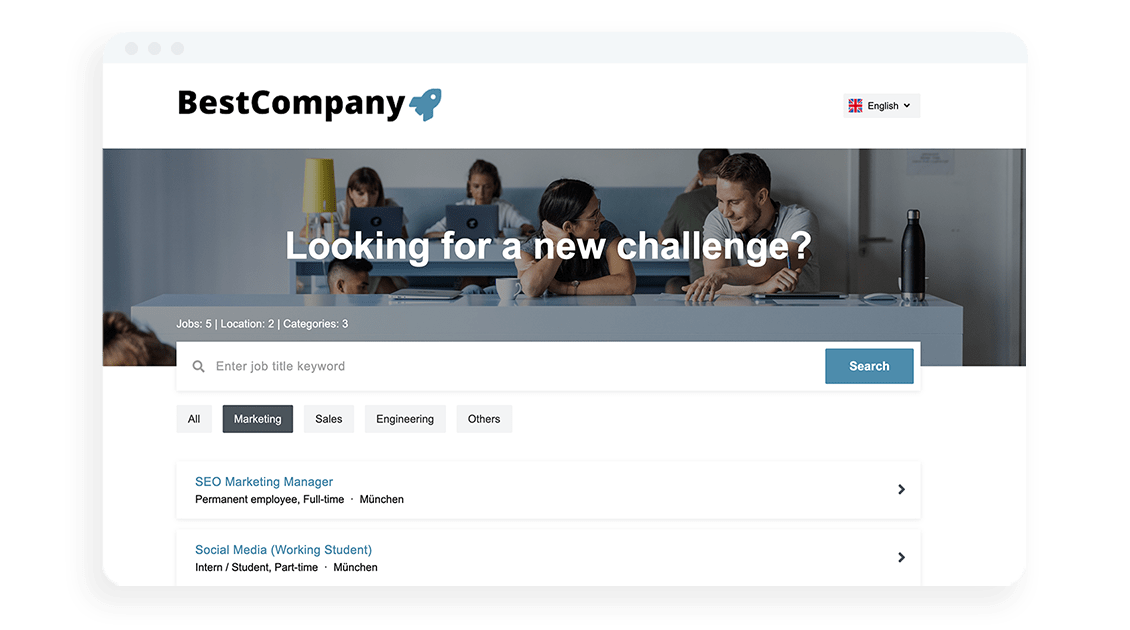29. September 2022
6 smart ways to accelerate your recruitment

If you have not already experienced firsthand the ‘Great Reshuffle’ and the fact that job vacancies across the UK have hit an all-time high – you may be about to.
Our recent HR study found that almost half (46%) of SMB employees in Europe are planning to look for a new job in the next 12 months. Yet 62% of employers are struggling to recruit the skilled talent they need.
So, how can you ensure that you are able to hire the right people at the right time? As Forbes reports, the hiring process has been completely transformed, with some now lasting as little as five days.
While that may not work for every organisation, trimming the less efficient parts of your recruitment likely is. When we streamlined ours, we made our hiring 40% faster and created a 100% offer acceptance rate.
Here’s the quickest way to accelerate your recruitment process – by using Personio’s powerful automation.
Find the skilled talent you need, fast – streamline your recruiting now.
1. Reduce time spent publishing ads
Before recruitment teams even begin to start receiving applications, they will need to invest time on their ads being seen in the right place at exactly the right time. In fact, Statista estimates that job boards account for almost half of global job applications. Each job board, and each job, takes a considerable time to fill out:
Steps without automation: | Steps with Personio: |
|---|---|
1. Logging into each job board using company details | You can create the full job ad in Personio and post it on 600 job boards with just one click. |
2. Creating a new listing by copying and pasting the job description | |
3. Adding any payment details and publishing each ad | |
4. Repeating the steps above for each job board |
2. Automatically organise new applications
For those who have ever worked in recruiting, you’ll know that talent acquisition teams can spend a lot of time in their inboxes, often receiving hundreds of applications a day. Without even considering the work that goes into applicant sourcing, talent teams will need to do the following once an application is received:

Steps without automation: | Steps with Personio: |
|---|---|
1. Sending an email acknowledging each of the potential hundreds of applications received and explaining the potential next steps (when and whether they may hear back if successful or unsuccessful, for example) | - The candidate automatically receives a confirmation email, complete with all the necessary information included (for example, Personio candidates receive a PDF with information about the company and the interview process). |
2. Downloading the applications and store them in their system and contact the relevant people to review their application | - All the application data is automatically saved in Personio and the recruiter responsible for the position is automatically notified. |
3. Accelerate how you follow up on interviews
Once you have selected a great candidate, it’s important to make the interview process as smooth as possible. A lack of communication can have a detrimental effect on your employer branding or even cost you potential new hires.
According to software rating site G2, an estimated 52% of candidates don’t receive any communication in the two to three months following application, while 63% will reject a job offer because of a bad candidate experience. Here’s a taste of what’s usually involved:
Steps without automation: | Steps with Personio: |
|---|---|
1. The recruiting team waiting for an initial evaluation from internal hiring teams before scheduling an interview | - You can use pre-written email templates, which will automatically fill in the candidates details. These are sent directly from Personio, automatically linked to the candidate’s profile and ensure accurate, consistent communication throughout their application process. |
2. Writing and sending an email inviting candidates to interview, attaching relevant information about the application process and company | - Recruiting teams can request initial feedback from the hiring team directly in Personio. The feedback is then securely stored in their profile and the recruiter is notified that is has been received. |
3. If a candidate is not suitable, writing and sending a response to them that you’ve chosen not to move ahead with their application | |
4. If a candidate is suitable, writing and sending a response sharing feedback and next steps for the interview | |
5. Experiencing ‘attention fragmentation’ because of these micro-delays |
4. Transform how you schedule interviews
Recruitment teams can on average spend nearly five days (4.75) on interviews, and that’s not even considering the time it takes to actually arrange them in the first place. For example, one study cites that the simple task of scheduling an interview can take anywhere from 30 minutes to two hours.
Steps without automation: | Steps with Personio: |
|---|---|
1. Contacting relevant hiring teams to check their availability or clicking into their calendar to check potential interview slots | - Interviewers can mark their available calendar slots from within Personio. The candidate can then select the best option from these. |
2. Potentially reaching out to candidates to check their availability | - Interviewers will automatically get role-based access to the applicant data – there is no need for recruiters to share it. |
3. Emailing candidates with the details of their interviews | - Meeting links from your chosen video-conference provider can be added directly to the interview invite, again from within Personio. |
4. Creating calendar invites, along with teleconferencing links | |
5. Rescheduling if the proposed interview slot doesn’t work |
5. Collect evaluations with ease
Following an interview, it can be extremely time-consuming to ensure that a) feedback is standardised b) feedback is collected and centralised in the right place and most importantly c) feedback is returned in a timely manner.
Without automation, ensuring that this all happens smoothly can involve:
Steps without automation: | Steps with Personio: |
|---|---|
1. Sending evaluation forms to each member of the hiring team (and creating them in the first place if they don’t yet exist) | - Once an interview is scheduled, evaluation forms are automatically sent to the hiring team who will be involved in the interviews. |
2. Reminding the hiring team to send these forms if the due date passes without having received them | - Reminders are sent to these interviewers until the evaluation forms are submitted. Once they are, they are automatically stored in the right candidate profile. |
3. Downloading the filled-in forms and uploading them to the right candidate file so that all their application information is stored in the right place | - Relevant stakeholders such as the hiring managers automatically receive a notification when an evaluation lands in the system. |
4. Potentially losing candidates if another company makes them an offer in the time it takes to do the above |

6. Make contract creation & signing seamless
With some estimates suggesting that the gap between interview and job offer can last on average anywhere from 20-40 days, it’s no wonder that the rejection rate of these offers can be nearly 20% for some industries.
In fact, HR Magazine reports that a shocking 50% of all UK professionals have declined a job offer because the hiring process was too long. So, it’s a part of the process which is extremely important to shave off time on, where you can.
Without automation, this lengthy process can involve:
Steps without automation: | Steps with Personio: |
|---|---|
1. Gathering all the candidates’ important details, along with compensation package that will be offered | - Recruiting teams can use a document template to quickly create a contract and fill in specific details such as name, address, title and compensation from their profile. This ensures that candidates aren’t missed due to other offers coming in ahead of yours. |
2. Contacting the legal team with this information, requesting them to draft a contract | - Candidates can use our Electronic Signature to sign and make their contract legally-binding in one click |
3. Waiting for this contract to be sent, downloading it and sending it to the hiring manager or HR for signing | - From here, HR teams can convert the candidate into an employee in just one click, and assign them an onboarding workflow to start getting organised ahead of their start date. |
4. Downloading the signed version, scanning and attaching this to send to the candidate | |
5. Sending this contract to the candidate, along with signing instructions | |
6. Waiting for the candidate to download, print, sign, scan and attach the contract to their email reply | |
7. Uploading this contract to the right employee file |
Is the speed of your recruiting process preventing you from landing great new talent? Find out how Personio’s applicant tracking system can help.

Hannah Popham
Hannah is a Senior Content Marketing Manager at Personio. She loves writing about the ever-changing ways that we work and how they intersect with our lives outside work.


